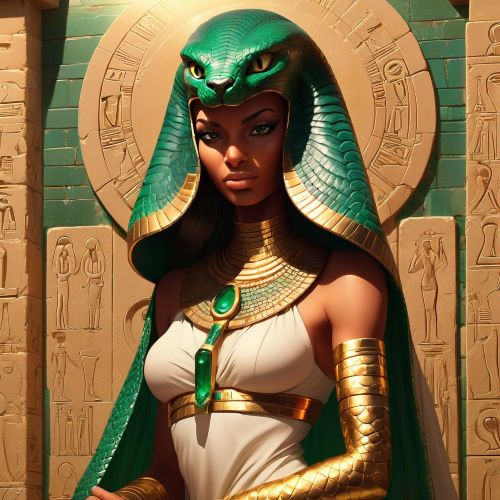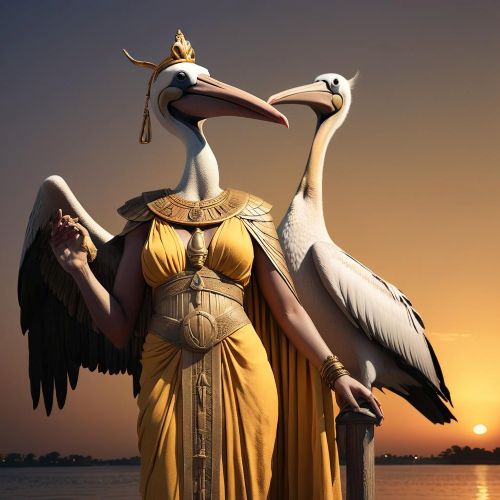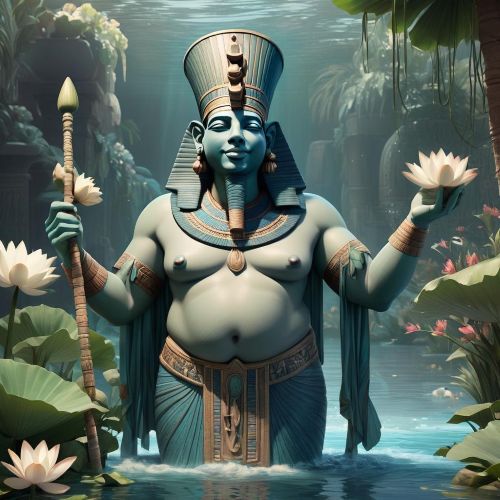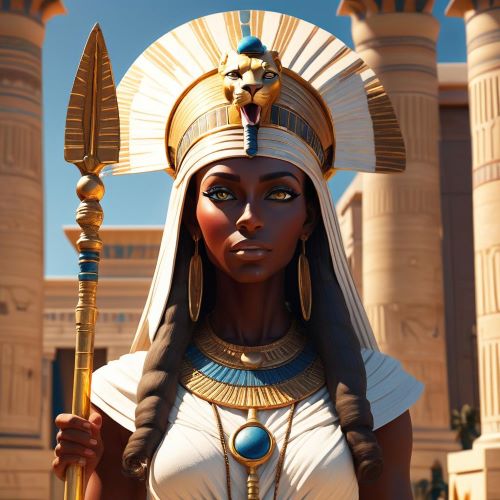
Wadjet : The Cobra Goddess
Listen
At a glance
| Description | |
|---|---|
| Origin | Egyptian Mythology |
| Classification | Gods |
| Family Members | N/A |
| Region | Egypt |
| Associated With | Protection |
Wadjet
Introduction
Wadjet is among the most enduring and powerful figures of ancient Egyptian mythology. Known as the tutelary goddess of Lower Egypt, she embodied protection, fertility, and sovereignty. Her name translates as “the Green One,” highlighting her association with growth, vegetation, and the fertile lands of the Nile Delta. Worship of Wadjet dates back to the Predynastic period (c. 6000–3150 BCE), making her one of the earliest deities of the Egyptian pantheon. Over time, she rose from a local cobra goddess of Buto (Per-Wadjet) to the divine protector of pharaohs and a central emblem of royal power.
Wadjet’s importance was not limited to kingship. She served as the “Eye of Ra,” a cosmic force sent out by the sun god to punish enemies and restore order. She was also seen as a nurturing guardian who watched over mothers and children, particularly in childbirth, while simultaneously carrying the fierce traits of a serpent capable of striking down any threat. This duality—nurturer and destroyer—helped cement her place as one of the most feared and revered goddesses of ancient Egypt.
Physical Traits
The most iconic image of Wadjet is the rearing cobra, its hood flared, poised to defend. This form, known as the uraeus, was a prominent emblem on the pharaoh’s crown, projecting divine authority and constant protection. The cobra’s striking nature symbolized the queenly power of Wadjet, whose venom was equated with fiery destruction of enemies.
In some depictions, she takes on a more anthropomorphic form as a woman with the head of a cobra, often crowned with the red Deshret, the crown of Lower Egypt. This crown reinforced her association with the Nile Delta region. Occasionally, she appears with wings, emphasizing her swiftness and ability to protect from all directions.
Her green coloring, reflected in her name, was a symbol of life and renewal. Artistic motifs sometimes show her intertwined with papyrus plants, the heraldic emblem of Lower Egypt, underscoring her role as its guardian. In other variations, she is represented as a lioness or even a solar serpent crowned with a disk, tying her directly to her role as the Eye of Ra.
Family
Wadjet’s familial connections are more symbolic than genealogical, yet they highlight her prominent role in the Egyptian divine hierarchy. In certain myths, she is the daughter of the sun god Ra, sent forth as his eye to retrieve his wandering children Shu and Tefnut. Her success in this mission earned her a place as Ra’s protector, often depicted on his brow ready to spit fire at enemies.
Wadjet also played a maternal role in the myth of Isis and Horus. She was believed to have helped hide and nurse the infant Horus in the marshes of the Delta after the murder of Osiris, shielding him from the wrath of Set. This nurturing aspect carried into funerary traditions, where she and Nekhbet, the vulture goddess of Upper Egypt, were shown nursing or guarding deceased kings in the afterlife.
Her most enduring partnership was with Nekhbet, together known as the “Two Ladies.” This duality symbolized the unification of Upper and Lower Egypt, ensuring the pharaoh was divinely sanctioned to rule both lands. In some local traditions, Wadjet was also paired with deities such as Ptah or Hapi, reflecting regional variations in her worship.
Other names
Like many Egyptian deities, Wadjet was known by a variety of names and titles that reflected her widespread veneration. She was called Wadjyt, Wadjit, Uto, Uatchet, Edjo, and Buto. The Greeks commonly referred to her as Uto or Buto, referencing the city of Buto, her main cult center in the Nile Delta.
Her epithets further illuminate her character. As the “Green One,” she was associated with fertility and renewal. As the “Lady of Flame” and “Mistress of Fear,” she embodied the terrifying aspect of fire and venom against enemies. When paired with Nekhbet, she became one half of the “Nebty” or “Two Ladies,” the joint protectors of a united Egypt. Through these names and titles, Wadjet was recognized as both a local guardian and a cosmic force of divine power.
Powers and Abilities
Wadjet’s abilities centered on her role as protector and enforcer of order. As the uraeus serpent, she was thought to spit fire at those who opposed the pharaoh or threatened the kingdom. This imagery appears in temple inscriptions and royal iconography, where the cobra is shown defending rulers against chaos.
Her powers extended into the cosmic realm through her identity as the Eye of Ra. In this role, she acted as an extension of the sun god’s wrath, sent to punish rebels and restore cosmic balance, or Ma’at. Unlike purely destructive forces, Wadjet balanced her ferocity with nurturing qualities. As protector of Horus, she ensured his survival, which in turn symbolized the continuity of legitimate kingship.
Beyond warfare and kingship, she was invoked for protection during childbirth, where her fierce yet maternal power shielded mothers and infants from harm. Her green symbolism tied her to the fertility of the Delta, making her a bringer of agricultural abundance. She was even credited in some myths with creating papyrus and the marshlands, binding her identity with the landscape itself.
Through amulets, seals, and temple carvings, her image reinforced authority, divine legitimacy, and personal protection. The Eye of Wadjet (often associated with the Eye of Horus in later traditions) became one of the most enduring symbols of healing, restoration, and safeguarding against evil.
Modern Day Influence
The legacy of Wadjet continues to shape modern culture, spirituality, and scholarship. Her cobra emblem remains one of the most recognizable images of ancient Egypt, appearing on artifacts such as Tutankhamun’s funerary mask, where the uraeus stands guard over the young king.
In contemporary spirituality, especially in Kemetic and neopagan practices, Wadjet is honored as a guardian figure invoked for protection, strength, and feminine power. The Eye of Wadjet remains a popular motif in jewelry, tattoos, and art, where it is believed to confer protection and good fortune.
Her influence also extends into popular culture. She has appeared in literature, including Rick Riordan’s The Crown of Ptolemy, and in video games such as Assassin’s Creed Origins and Age of Mythology. Even modern companies, such as Wadjet Eye Games, draw inspiration from her symbolism, showing the enduring appeal of her image as a guardian of hidden wisdom and power.
Archaeologically, Wadjet provides key insights into Egyptian religion and political identity. Her central role in representing Lower Egypt highlights the ways deities were tied to geography and state power. The pairing of Wadjet with Nekhbet continues to be studied as a reflection of the ideological importance of unity in Egyptian kingship.
Today, she stands as more than just an ancient mythological figure. Wadjet represents the timeless human desire for protection, justice, and renewal. Whether as the fiery cobra striking at enemies or the green goddess nurturing new life, she remains a powerful emblem of resilience and divine authority.
Related Images
Source
Ancient Egypt Tours. (2024, November 1). Wadjet goddess of kingship. Retrieved September 30, 2025, from https://ancientegypttours.com/wadjet-goddess-of-kingship/
Ancient Egypt Online. (2020, October 31). Wadjet. Retrieved September 30, 2025, from https://ancientegyptonline.co.uk/wadjet/
Encyclopaedia Britannica. (1998, July 19). Wadjet | Protector, Ancient Symbol & Cobra. Retrieved September 30, 2025, from https://www.britannica.com/topic/Wadjet
Wikipedia. (2025, September 15). Wadjet. Retrieved September 30, 2025, from https://en.wikipedia.org/wiki/Wadjet
Study.com. (1999, December 31). Wadjet in Egyptian mythology | Symbols, depiction & origins. Retrieved September 30, 2025, from https://study.com/academy/lesson/wadjet-symbol-facts-overview-snake-egyptian-goddess.html
Colonna, A. (2015, August 31). Panthe(ri)on: Ritual practice and cultural construction of Egyptian animal worship. Academia.edu. https://www.academia.edu/15328864/PANTHE_RI_ON_RITUAL_PRACTICE_AND_CULTURAL_CONSTRUCTION_OF_EGYPTIAN_ANIMAL_WORSHIP_A_HISTORICAL_RELIGIOUS_PERSPECTIVE
YouTube. (2025, June 23). The powerful cobra goddess of Egyptian mythology [Video]. https://www.youtube.com/watch?v=F1W43_btG6A
University of Chicago. (n.d.). The Beheditte. https://isac.uchicago.edu/sites/default/files/uploads/shared/docs/SHONKWILERDISSERTATION.pdf
Frequently Asked Questions
What is lorem Ipsum?
I am text block. Click edit button to change this text. Lorem ipsum dolor sit amet, consectetur adipiscing elit. Ut elit tellus, luctus nec ullamcorper mattis, pulvinar dapibus leo.
What is lorem Ipsum?
I am text block. Click edit button to change this text. Lorem ipsum dolor sit amet, consectetur adipiscing elit. Ut elit tellus, luctus nec ullamcorper mattis, pulvinar dapibus leo.
What is lorem Ipsum?
I am text block. Click edit button to change this text. Lorem ipsum dolor sit amet, consectetur adipiscing elit. Ut elit tellus, luctus nec ullamcorper mattis, pulvinar dapibus leo.
What is lorem Ipsum?
I am text block. Click edit button to change this text. Lorem ipsum dolor sit amet, consectetur adipiscing elit. Ut elit tellus, luctus nec ullamcorper mattis, pulvinar dapibus leo.
What is lorem Ipsum?
I am text block. Click edit button to change this text. Lorem ipsum dolor sit amet, consectetur adipiscing elit. Ut elit tellus, luctus nec ullamcorper mattis, pulvinar dapibus leo.














